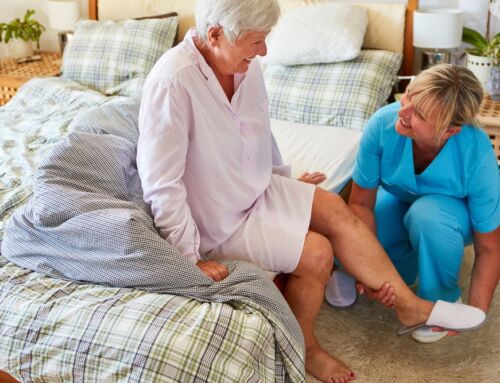As people age, their health and lifestyle needs naturally evolve, and so should the support they receive. If you’ve been exploring senior living options, especially continuing care retirement communities (CCRCs, also known as life plan communities), you’ve probably come across the term “continuum of care.” It’s a key concept that speaks to the range of support and services retirement communities may offer, yet many prospective residents find the term a bit confusing. So, what does continuum of care mean, and why does it matter when choosing a place to call home as you age?
How to define ‘continuum of care’
A continuum of care describes the range and progression of support and/or healthcare services that a person may require as they age and their needs evolve. Think of it as a spectrum of care that spans from full independence to full-time medical care.
At the left side of the spectrum is independent living. This senior living option is ideal for older adults who are active, self-sufficient, and capable of managing daily tasks on their own, but who prefer the convenience, social opportunities, and low-maintenance lifestyle offered by a retirement community.
As we move along the continuum, we reach personal care or assisted living. Here, residents may need help with certain activities of daily living (ADLs) such as bathing, dressing, or managing medications. People in an assisted living setting may be there temporarily, such as for a short-term stay for rehabilitation services following an illness or surgery, or they may live there more permanently for long-term care needs.
It’s important to understand that assisted living is typically designed for non-medical support, however. That being said, not all assisted living communities are the same. Some are better equipped than others to support residents with higher care needs, offering services that begin to approach the level of support provided in skilled nursing, though they usually stop short of delivering licensed medical treatments.
As we reach the far end of the spectrum, we find skilled nursing care, or what was traditionally referred to as a nursing home. This highest level of care is for individuals with significant medical conditions or advanced cognitive impairment who require 24/7 supervision and/or regular care from licensed healthcare professionals.
The care spectrum also includes memory care, which can provide assisted living-level services or skilled nursing care, depending on the person’s needs. Memory care offers a secure, structured environment and specialized care and support for those experiencing cognitive decline due to dementia, including Alzheimer’s disease.
What makes the continuum of care model unique?
There are certain retirement communities that offer just one of these options along the spectrum of care. For instance, maybe the community is exclusively a 55+ independent living community or an active adult community that provides no on-site care services for residents. (Although a resident could of course contract with an in-home care services provider to meet their specific short- or long-term care needs.) Or perhaps a senior living community is solely focused on those who need assisted living or memory care. Others may provide some care services, but stop short of advanced healthcare and nursing care services.
What makes the continuum of care model unique within the world of senior living is its flexibility. Often referred to as Continuing Care Retirement Communities (CCRCs or “life plan communities”), these communities enable their residents to transition smoothly between care levels, often without needing to move to a new community.
>> Related: Am I Healthy Enough to Move to a Life Plan Community?
Stages of a continuum of care in a CCRC/lifeplan community
By choosing a retirement community with a full continuum of care, such as a CCRC, older adults can enjoy the peace of mind that comes with knowing they’ll have access to all the services they’ll need in the future without being a burden on adult children or other family members.
Let’s take a more in-depth look at each of these levels within the continuum of care at a CCRC.
Independent living
The independent living section of a CCRC offers active adults the freedom of a maintenance-free lifestyle while enjoying access to amenities like on-site dining, social activities, and wellness services. Independent living residents of a CCRC benefit from a sense of community and security, with the peace of mind that support is available if and when it’s needed.
It’s important to note that the majority of CCRCs require new residents to initially be capable of safely living within the independent living portion of the community. Most will have a health evaluation required of new residents to verify that they are healthy enough to live independently.
>> Related: Understanding the Different Forms of Independent Living
Assisted living and rehabilitation services
The assisted living services of a CCRC provide residents support with activities of daily living (ADLs), such as bathing, dressing, and medication management. Again, such care may be needed just for a short time, or it may be necessary on a long-term basis, depending on the older adult’s unique situation.
Sometimes, assisted living services at a CCRC may be provided to the resident within their independent living residence. In other cases, the resident may need to move to the assisted living portion of the CCRC. In either scenario, however, assisted living is designed to help CCRC residents maintain their independence while receiving the daily support they need to stay safe and comfortable.
Rehabilitation services is another subcategory of assisted living. Whether a CCRC resident is recovering from surgery, illness, or injury, rehabilitation services (including physical, occupational, and speech therapies) play a critical role in helping the resident regain strength, mobility, and independence.
>> Related: Transfer to a Higher Level of Care at a CCRC: Who Decides?
Skilled nursing care
The skilled nursing care is for CCRC residents who require around-the-clock medical attention or recovery support. This may include post-surgical care, chronic disease management, or long-term care for serious health conditions.
This highest level of care on the continuum offers professional nursing care in a licensed health setting. It can be provided either on-site in a CCRC’s healthcare center or at an off-site care facility, depending on the CCRC’s campus setup.
Memory care
A subcategory of both assisted living and skilled nursing care, specialized memory care for CCRC residents living with Alzheimer’s disease or other forms of dementia focuses on cognitive support, safety, and structured routines. Staff in this field of care are specially trained to manage the unique needs of people with memory loss.
>> Related: Evaluating Care, Quality, and Access at a CCRC’s Healthcare Center
Benefits of a CCRC’s continuum of care model …
There is no one-size-fits-all when it comes to senior living decisions. Some people want to remain in their current home no matter what their care needs may eventually be. Others prefer to downsize to a 55+ independent living retirement community, and then may relocate to a care community should their needs change down the road. And some decide that a single move to a CCRC with its access to a continuum of care is the best fit for their senior living goals.
For those who opt for a CCRC, there are a number of benefits they may experience as a result of the community’s continuum of care model.
- Easier transitions: CCRC residents can move between care levels without leaving the community, reducing stress and disruption, and also allowing couples to remain close to each other even if they have differing care needs.
- Personalized care plans: Many CCRCs will provide regular assessments ensure that care plans are tailored to the individual resident’s unique needs.
- Enhanced quality of life: Access to appropriate care levels ensures residents maintain as much independence as they safely can, as well as the highest possible quality of life.
- Peace of mind: CCRC residents can rest easy knowing that their evolving needs will be met without having to move to a new, unfamiliar community.
… and potential drawbacks of a CCRC’s continuum of care
Not everyone will find that a continuum of care model, and more specifically a CCRC, is the right senior living choice for them. It’s important to consider some of the potential drawbacks before making a commitment to a community, for instance:
- High upfront costs: Many CCRCs require a significant entrance fee in addition to monthly fees, which can be a downside or barrier for some individuals or families.
- Complex contracts: CCRC contracts can be difficult to understand and impact future costs and coverage of care services.
- Health qualification requirements: As mentioned, most CCRCs require new residents to be in relatively good health upon entry, limiting access for those who already need higher levels of care.
- Less flexibility in moving to a different level of care: While CCRCs offer multiple levels of care on one campus, transferring between units or levels of care may still be subject to availability of space and internal policies.
- Transferring when you may not be mentally ready: On the flip side, there are occasional cases where a CCRC resident doesn’t feel like they need to move to a higher level of care, but the community believes it is in the best interest of the resident’s health and safety, which may create strife between the two parties.
- Not all-inclusive: Depending on your contract, certain healthcare services, medications, or personal care needs may not be fully covered by your monthly fees and could result in additional out-of-pocket expenses.
>> Related: Transfer to a Higher Level of Care at a CCRC: Who Decides?
Choosing a senior living community that’s right for you
When considering a senior living community, it’s essential to understand what, if any, care services are offered. For those that provide a continuum of care, like a CCRC, evaluate the community’s ability to provide comprehensive care, the qualifications of the staff, the quality of the healthcare center, and the availability of specialized services like memory care and rehabilitation.
It is also essential to understand the details of your CCRC contract. Depending on your contract type, your monthly fees may or may not change should you require a higher level of care. You also want to understand how transfers between levels of care are handled. Learn more about the differences in contract types in our Primer on CCRC Residency Contracts.
Finally, whether you’re planning for yourself or a loved one, know that CCRCs are designed to evolve with each resident, ensuring that as needs change, their home doesn’t have to. For those who opt for a community with a full continuum of care, they’re investing in comfort, stability, and quality of life for years to come.
Originally posted July 10, 2017; updated July 15, 2025

FREE Detailed Profile Reports on CCRCs/Life Plan Communities
Search Communities






